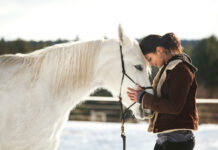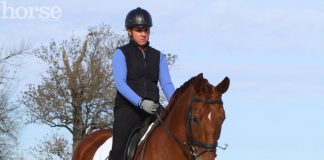
Lucinda Fredericks on the cross-country course at the 2009 Rolex Kentucky Three-Day Event with Headley Britannia. The pair won the event that year.
Reins – Always use reins that buckle at the bit. Fredericks recalls seeing a nasty accident that occurred after a pair of new, billeted (hook) reins broke. Also, make sure you’re using reins that won’t slip through your hands when your horse starts to sweat, or if rains.
Noseband – Make sure the cavesson rests under the cheek bones and that the flash strap (or the bottom part of your figure-eight) is not too low on the horse’s nostrils.
Bit – “You’ve got to be confident that you have your horse in the right bit,” says Fredericks, who discourages her students from using loose-ring bits, unless they are used with bit guards. Otherwise, she recommends a D-ring, a full-cheek, or an eggbutt so the rings stay in place on either side of the horse’s mouth. “I’ve seen horses on the cross-country course with the entire bit on one side of their face, with the loose ring sitting on the tongue,” she says.
The breastplate – The breastplate offers the event rider something to hang on to if necessary and it completes the proper turnout for an event horse. “Most importantly, it prevents the saddle from slipping back,” says Fredericks. She recommends an elasticized breast plate.
Saddle – “Wherever we teach, someone always turns up with a saddle that’s sitting on their horse’s spine,” says Fredericks. Work with a saddle fitter to make sure your saddle fits your horse properly. For a comfortable fit during cross-country jumping, Fredericks says you should be able to get three fingers between the horse’s spine and the saddle when the girth is tightened.
Girth – Make sure your girth has elastic on at least one side. This way, even if the girth is tightened, he can take a good deep breath when he gets to the top of a big hill. Fredericks also recommends a stud guard girth for cross-country jumping. “I have seen horses get serious marks under their tummies, even without studs,” she says. “This can be very distracting and uncomfortable for a horse.”

Canadian eventer Hawley Bennett-Awad shown here wearing a Point Two air vest at the 2014 Rolex Kentucky Three-Day Event.
Body protectors – Don’t ride cross-country without a body protector, advises Fredericks. “I also wear a Point-Two Air Jacket, which inflates if you are separated from your horse,” she says (a bungee cord attached to your saddle breaks loose and inflates the vest if you fall off). “It has saved me from being winded and badly bruised from a fall. It doesn’t replace the body protector, however.” Click here for advice on selecting a safety vest.
Helmets – Never use a helmet with a hard peak (brim) that doesn’t detatch on impact, says Fredericks. Instead, use a skull cap. “We never ride cross-country without our crash hats,” she says.






Great advice.
Awesome advice.